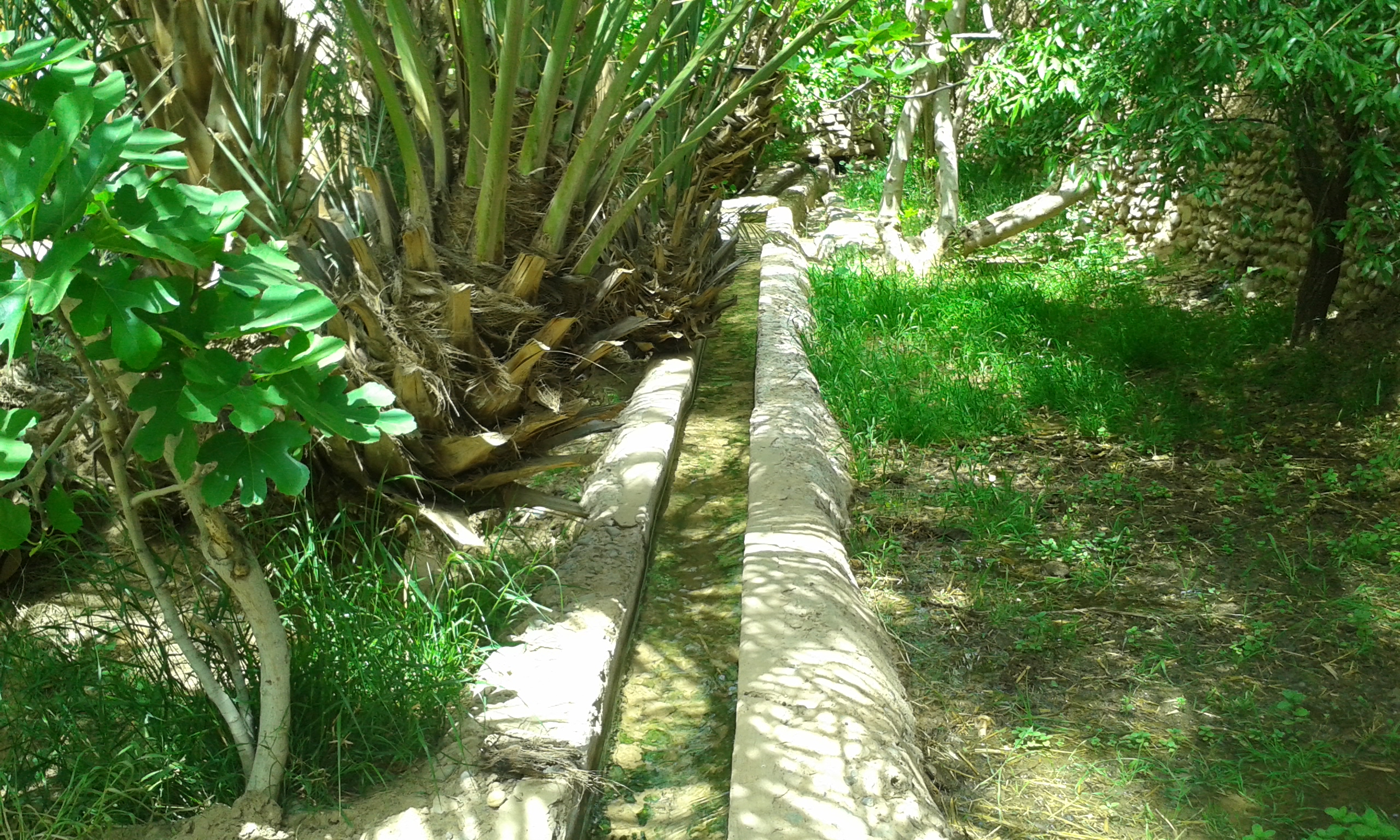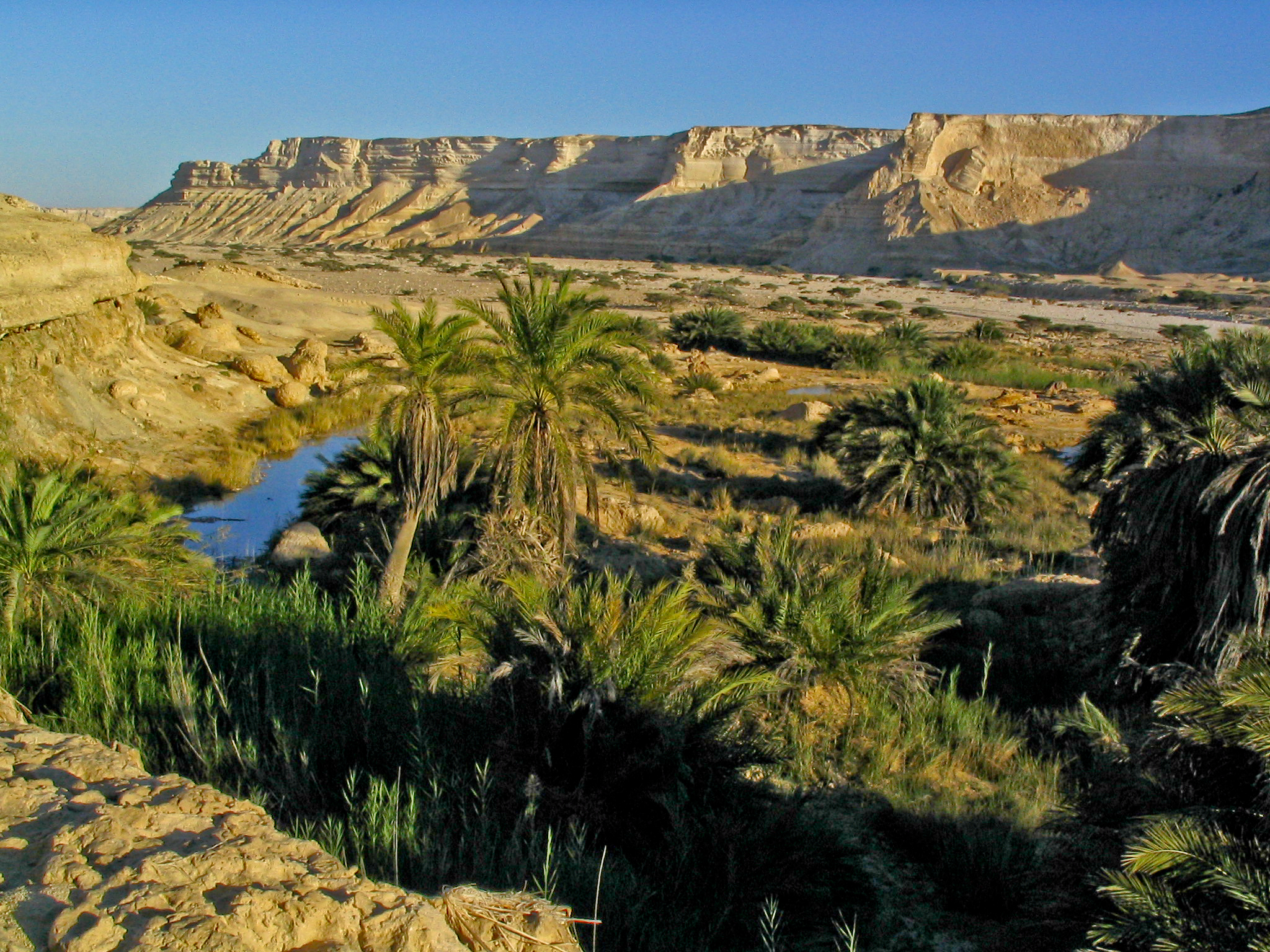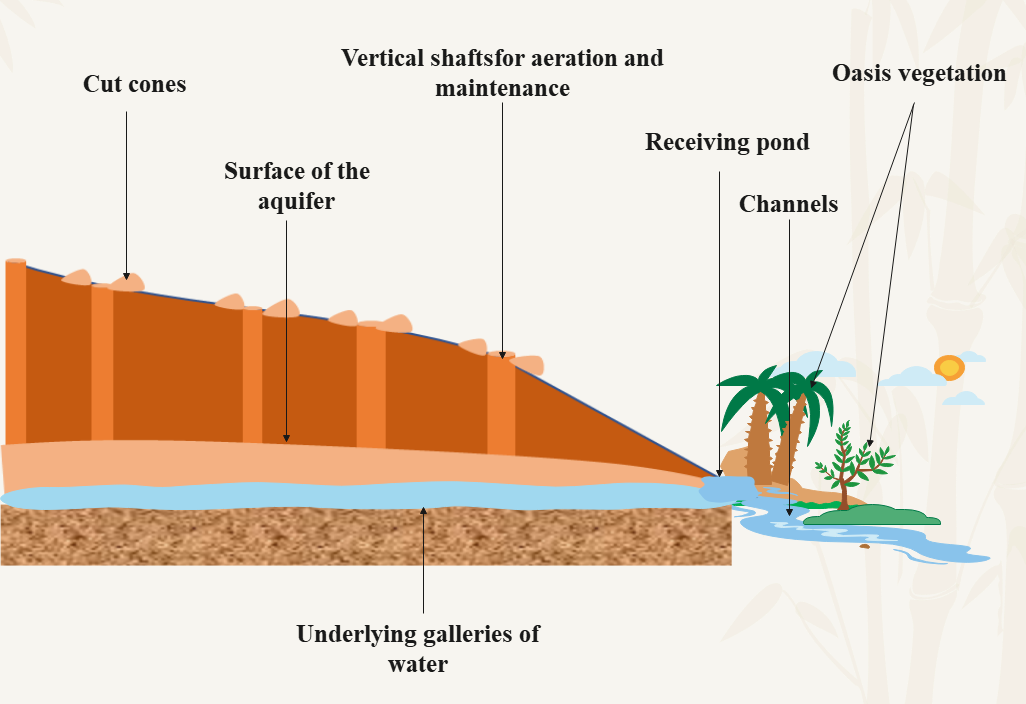Oasis on:
[Wikipedia]
[Google]
[Amazon]
In
. that sustains plant life and provides habitat for animals. Surface water may be present, or water may only be accessible from wells or underground channels created by humans. In geography, an oasis may be a current or past rest stop on a transportation route, or less-than-verdant location that nonetheless provides access to underground water through deep wells created and maintained by humans. Although they depend on a natural condition, such as the presence of water that may be stored in reservoirs and used for irrigation, most oases, as we know them, are artificial. The word ''oasis'' came into English from , from , , which in turn is a direct borrowing from Demotic Egyptian. The word for ''oasis'' in the latter-attested
. . Some of the possible human contributions to maintaining an oasis include digging and maintaining wells, digging and maintaining canals, and continuously removing opportunistic plants that threaten to gorge themselves on water and fertility needed to maintain human and animal food supplies. Stereotypically, an oasis has a "central pool of open water surrounded by a ring of water-dependent shrubs and trees…which are in turn encircled by an outlying transition zone to desert plants." Rain showers provide subterranean water to sustain natural oases, such as the Tuat. Substrata of impermeable rock and stone can trap water and retain it in pockets, or on long faulting subsurface ridges or volcanic dikes water can collect and percolate to the surface. Any incidence of water is then used by migrating birds, which also pass seeds with their droppings which will grow at the water's edge forming an oasis. It can also be used to plant crops.



ecology
Ecology () is the natural science of the relationships among living organisms and their Natural environment, environment. Ecology considers organisms at the individual, population, community (ecology), community, ecosystem, and biosphere lev ...
, an oasis (; : oases ) is a fertile area of a desert
A desert is a landscape where little precipitation occurs and, consequently, living conditions create unique biomes and ecosystems. The lack of vegetation exposes the unprotected surface of the ground to denudation. About one-third of the la ...
or semi-desert environmentBattesti, Vincent (2005) Jardins au désert: Évolution des pratiques et savoirs oasiens: Jérid tunisien. Paris: IRD éditions.. that sustains plant life and provides habitat for animals. Surface water may be present, or water may only be accessible from wells or underground channels created by humans. In geography, an oasis may be a current or past rest stop on a transportation route, or less-than-verdant location that nonetheless provides access to underground water through deep wells created and maintained by humans. Although they depend on a natural condition, such as the presence of water that may be stored in reservoirs and used for irrigation, most oases, as we know them, are artificial. The word ''oasis'' came into English from , from , , which in turn is a direct borrowing from Demotic Egyptian. The word for ''oasis'' in the latter-attested
Coptic language
Coptic () is a dormant language, dormant Afroasiatic languages, Afroasiatic language. It is a group of closely related Egyptian dialects, representing the most recent developments of the Ancient Egyptian language, Egyptian language, and histori ...
(the descendant of Demotic Egyptian) is ''wahe'' or ''ouahe'' which means a "dwelling place". Oasis in Arabic is ''wāḥa'' ().
Description
Oases develop in " hydrologically favored" locations that have attributes such as a high water table, seasonal lakes, or blockaded wadis. Oases are made when sources of freshwater, such as springs, underground rivers, oraquifer
An aquifer is an underground layer of water-bearing material, consisting of permeability (Earth sciences), permeable or fractured rock, or of unconsolidated materials (gravel, sand, or silt). Aquifers vary greatly in their characteristics. The s ...
s irrigate the surface naturally or via man-made wells. The presence of water on the surface or underground is necessary and the local or regional management of this essential resource is strategic, but not sufficient to create such areas: continuous human work and know-how (a technical and social culture) are essential to maintain such ecosystems.Vincent Battesti, The Power of a Disappearance: Water in the Jerid region of Tunisia ''in'' B. R. Johnston ''et al.'' (eds), ''Water, Cultural Diversity & Global Environmental Change: Emerging Trends, Sustainable Futures?'', 2012, UNESCO/Springer, . . Some of the possible human contributions to maintaining an oasis include digging and maintaining wells, digging and maintaining canals, and continuously removing opportunistic plants that threaten to gorge themselves on water and fertility needed to maintain human and animal food supplies. Stereotypically, an oasis has a "central pool of open water surrounded by a ring of water-dependent shrubs and trees…which are in turn encircled by an outlying transition zone to desert plants." Rain showers provide subterranean water to sustain natural oases, such as the Tuat. Substrata of impermeable rock and stone can trap water and retain it in pockets, or on long faulting subsurface ridges or volcanic dikes water can collect and percolate to the surface. Any incidence of water is then used by migrating birds, which also pass seeds with their droppings which will grow at the water's edge forming an oasis. It can also be used to plant crops.
Geography
Oases in theMiddle East
The Middle East (term originally coined in English language) is a geopolitical region encompassing the Arabian Peninsula, the Levant, Turkey, Egypt, Iran, and Iraq.
The term came into widespread usage by the United Kingdom and western Eur ...
and North Africa
North Africa (sometimes Northern Africa) is a region encompassing the northern portion of the African continent. There is no singularly accepted scope for the region. However, it is sometimes defined as stretching from the Atlantic shores of t ...
cover about , however, they support the livelihood of about 10 million inhabitants. The stark ratio of oasis to desert land in the world means that the oasis ecosystem
An ecosystem (or ecological system) is a system formed by Organism, organisms in interaction with their Biophysical environment, environment. The Biotic material, biotic and abiotic components are linked together through nutrient cycles and en ...
is "relatively minute, rare and precious."
There are 90 “major oases” within the Sahara Desert. Some of their fertility may derive from irrigation systems called '' foggaras'', ''khettaras'', ''lkhttarts'', or a variety of other regional names''.''
In some oases systems, there is "a geometrical system of raised channels that release controlled amounts of the water into individual plots, soaking the soil."

History
Oases often have human histories that are measured in millennia. Archeological digs at Ein Gedi in the Dead Sea Valley have found evidence of settlement dating to 6,000 BC. Al-Ahsa on the Arabian Peninsula shows evidence of human residence dating to theNeolithic
The Neolithic or New Stone Age (from Ancient Greek, Greek 'new' and 'stone') is an archaeological period, the final division of the Stone Age in Mesopotamia, Asia, Europe and Africa (c. 10,000 BCE to c. 2,000 BCE). It saw the Neolithic Revo ...
.
Anthropologically, the oasis is "an area of sedentary life, which associates the city 'medina''or village 'ksar''">ksar.html" ;"title="'ksar">'ksar''with its surrounding feeding source, the palm grove, within a relational and circulatory nomadic system."
The location of oases has been of critical importance for trade and transportation routes in desert areas; caravans must travel via oases so that supplies of water and food can be replenished. Thus, political or military control of an oasis has in many cases meant control of trade on a particular route. For example, the oases of Awjila, Ghadames and Kufra, situated in modern-day Libya, have at various times been vital to both north–south and east–west Trans-Saharan trade, trade in the Sahara Desert. The location of oases also informed the Darb El Arba'īn trade route from Sudan to Egypt, as well as the caravan route from the Niger River to Tangier, Morocco. The Silk Road "traced its course from water hole to water hole, relying on oasis communities such as Turpan in China and Samarkand
Samarkand ( ; Uzbek language, Uzbek and Tajik language, Tajik: Самарқанд / Samarqand, ) is a city in southeastern Uzbekistan and among the List of oldest continuously inhabited cities, oldest continuously inhabited cities in Central As ...
in Uzbekistan."
According to the United Nations, "Oases are at the very heart of the overall development of peri-Saharan countries due to their geographical location and the fact they are preferred migration routes in times of famine or insecurity in the region."
Oases in Oman
Oman, officially the Sultanate of Oman, is a country located on the southeastern coast of the Arabian Peninsula in West Asia and the Middle East. It shares land borders with Saudi Arabia, the United Arab Emirates, and Yemen. Oman’s coastline ...
, on the Arabian Peninsula
The Arabian Peninsula (, , or , , ) or Arabia, is a peninsula in West Asia, situated north-east of Africa on the Arabian plate. At , comparable in size to India, the Arabian Peninsula is the largest peninsula in the world.
Geographically, the ...
near the Persian Gulf
The Persian Gulf, sometimes called the Arabian Gulf, is a Mediterranean seas, mediterranean sea in West Asia. The body of water is an extension of the Arabian Sea and the larger Indian Ocean located between Iran and the Arabian Peninsula.Un ...
, vary somewhat from the Saharan form. While still located in an arid or semi-arid zone with a date palm overstory, these oases are usually located ''below plateaus'' and "watered either by springs or by ''aflaj'', tunnel systems dug into the ground or carved into the rock to tap underground aquifers." This rainwater harvesting system "never developed a serious salinity problem."


Palm Oasis
In the drylands of southwestern North America, there is a habitat form called Palm Oasis (alternately Palm Series or Oasis Scrub Woodland) that has the native California fan palm as the overstory species. These Palm Oases can be found inCalifornia
California () is a U.S. state, state in the Western United States that lies on the West Coast of the United States, Pacific Coast. It borders Oregon to the north, Nevada and Arizona to the east, and shares Mexico–United States border, an ...
, Arizona
Arizona is a U.S. state, state in the Southwestern United States, Southwestern region of the United States, sharing the Four Corners region of the western United States with Colorado, New Mexico, and Utah. It also borders Nevada to the nort ...
, Baja California, and Sonora
Sonora (), officially Estado Libre y Soberano de Sonora (), is one of the 31 states which, along with Mexico City, comprise the Administrative divisions of Mexico, Federal Entities of Mexico. The state is divided into Municipalities of Sonora, 72 ...
.
Agroforestry
People who live in an oasis must manage land and water use carefully. The most important plant in an oasis is the date palm ( ''Phoenix dactylifera'' L.), which forms the upper layer. These palm trees provide shade for smaller understory trees like apricots, figs,olive
The olive, botanical name ''Olea europaea'' ("European olive"), is a species of Subtropics, subtropical evergreen tree in the Family (biology), family Oleaceae. Originating in Anatolia, Asia Minor, it is abundant throughout the Mediterranean ...
s, and peach
The peach (''Prunus persica'') is a deciduous tree first domesticated and Agriculture, cultivated in China. It bears edible juicy fruits with various characteristics, most called peaches and the glossy-skinned, non-fuzzy varieties called necta ...
trees, which form the middle layer. Market-garden vegetables, some cereals (such as sorghum
''Sorghum bicolor'', commonly called sorghum () and also known as great millet, broomcorn, guinea corn, durra, imphee, jowar, or milo, is a species in the Poaceae, grass genus ''Sorghum (genus), Sorghum'' cultivated for its grain. The grain i ...
, barley, millet
Millets () are a highly varied group of small-seeded grasses, widely grown around the world as cereal crops or grains for fodder and human food. Most millets belong to the tribe Paniceae.
Millets are important crops in the Semi-arid climate, ...
, and wheat
Wheat is a group of wild and crop domestication, domesticated Poaceae, grasses of the genus ''Triticum'' (). They are Agriculture, cultivated for their cereal grains, which are staple foods around the world. Well-known Taxonomy of wheat, whe ...
), and/or mixed animal fodder, are grown in the bottom layer where there is more moisture. The oasis is integrated into its desert environment through an often close association with nomadic transhumant livestock farming (very often pastoral and sedentary populations are clearly distinguished). The fertility of the oasis soil is restored by "cyclic organic inputs of animal origin." In summary, an oasis palm grove is a highly anthropized and irrigated area that supports a traditionally intensive and polyculture-based agriculture.
Responding to environmental constraints, the three strata create what is called the " oasis effect". The three layers and all their interaction points create a variety of combinations of "horizontal wind speed, relative air temperature and relative air humidity." The plantings—through a virtuous cycle of wind reduction, increased shade and evapotranspiration—create a microclimate favorable to crops; "measurements taken in different oases have showed that the potential evapotranspiration of the areas was reduced by 30 to 50 percent within the oasis."
The keystone date palm trees are "a main income source and staple food for local populations in many countries in which they are cultivated, and have played significant roles in the economy, society, and environment of those countries." Challenges for date palm oasis polycultures include "low rainfall, high temperatures, water resources often high in salt content, and high incidence of pests."
Distressed systems
Many historic oases have struggled with drought and inadequate maintenance. According to a United Nations report on the future of oases in the Sahara and Sahel, "Increasingly... oases are subject to various pressures, heavily influenced by the effects ofclimate change
Present-day climate change includes both global warming—the ongoing increase in Global surface temperature, global average temperature—and its wider effects on Earth's climate system. Climate variability and change, Climate change in ...
, decreasing groundwater levels and a gradual loss of cultural heritage due to a fading historical memory concerning traditional water management techniques. These natural pressures are compounded by demographic pressures and the introduction of modern water pumping techniques that can disrupt traditional resource management schemes, particularly in the North Saharan oases."
For example, five historic oases in the Western Desert of Egypt ( Kharga, Dakhla, Farafra, Baharyia, and Siwa) once had "flowing spring and wells" but due to the decline of groundwater heads because of overuse for land reclamation projects those water sources are no more and the oases suffer as a result.
Morocco has lost two-thirds of its oasis habitat over the last 100 years due to heat, drought, and water scarcity. The Ferkla Oases in Morocco once drew on water from the Ferkla, Sat and Tangarfa Rivers but they are now dry but for a few days a year.
List of places called oases
New World dryland systems with oasis-like attributes
* Huacachina, Peru * Quitobaquito, Organ Pipe Cactus National Monument, Arizona * Kitowok, Sonora, Mexico * Fish Springs National Wildlife Refuge inUtah
Utah is a landlocked state in the Mountain states, Mountain West subregion of the Western United States. It is one of the Four Corners states, sharing a border with Arizona, Colorado, and New Mexico. It also borders Wyoming to the northea ...
, United States
The United States of America (USA), also known as the United States (U.S.) or America, is a country primarily located in North America. It is a federal republic of 50 U.S. state, states and a federal capital district, Washington, D.C. The 48 ...
* Havasu Falls, Grand Canyon, Arizona
* Zzyzx in Mojave National Preserve, California
California () is a U.S. state, state in the Western United States that lies on the West Coast of the United States, Pacific Coast. It borders Oregon to the north, Nevada and Arizona to the east, and shares Mexico–United States border, an ...
* Cuatro Ciengas basin, Chihuahuan Desert, Mexico
* Oasis Spring Ecological Reserve, Salton Sea, California
Gallery of oases
Practical matters
A 1920 USGS publication about watering holes in the deserts of California and Arizona gave this advice for travelers seeking oases:See also
* – the world's largest irrigation project; developed in Libya to connect cities withfossil water
Fossil water, fossil groundwater, or paleowater is an ancient body of water that has been contained in some undisturbed space, typically groundwater in an aquifer, for millennia. Other types of fossil water can include subglacial lakes, such as An ...
.
*
*
*
*
*
*
*
*
* Lençóis Maranhenses National Park (Brazil)
* Great Green Wall (disambiguation)
* Aflaj Irrigation Systems of Oman
* Palmeral of Elche
* Fog oasis (South America)
References
Bibliography
*External links
* {{Authority control Lacustrine landforms Waystations